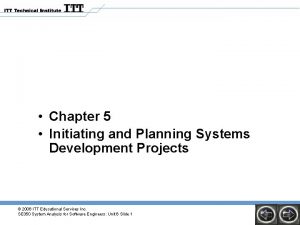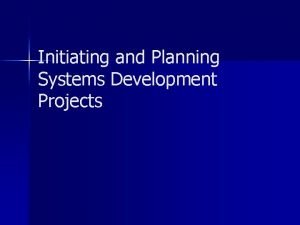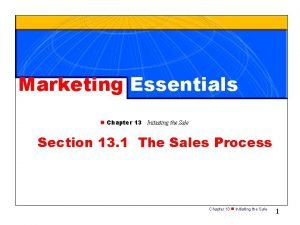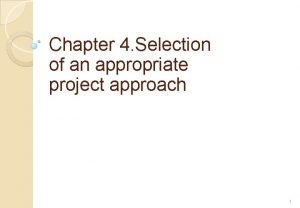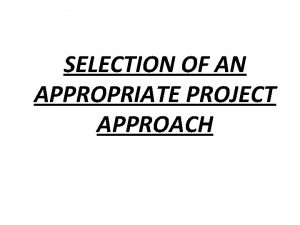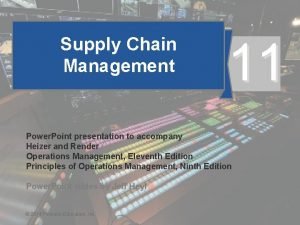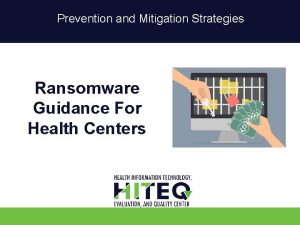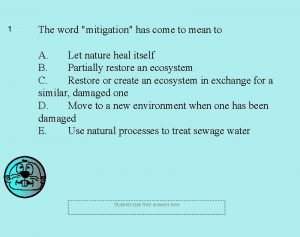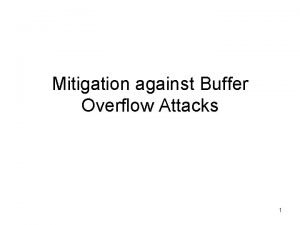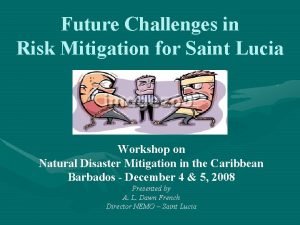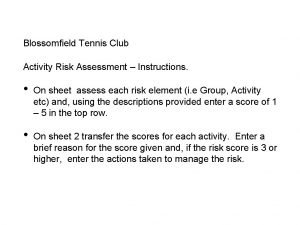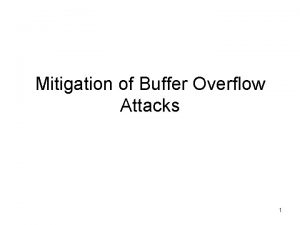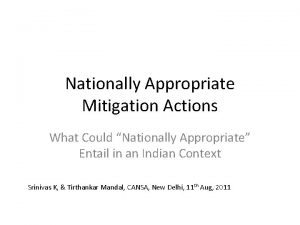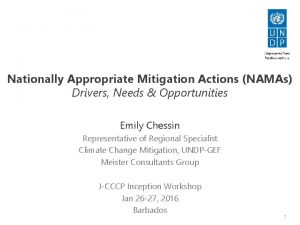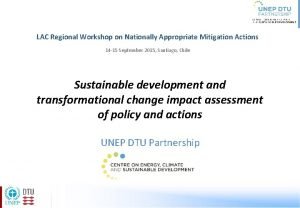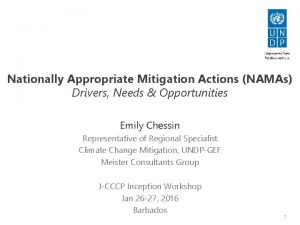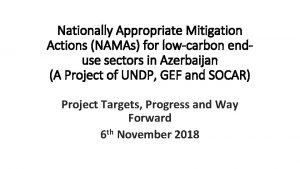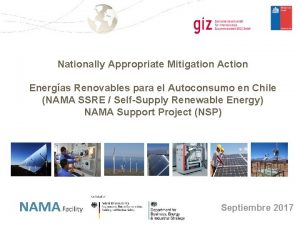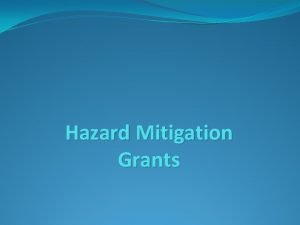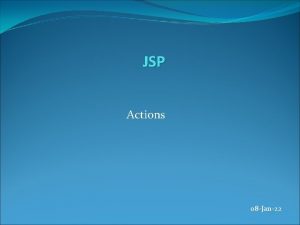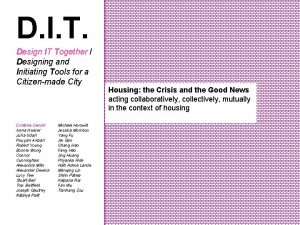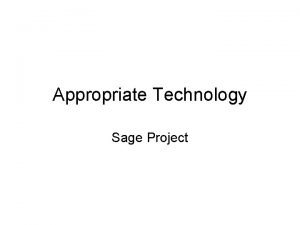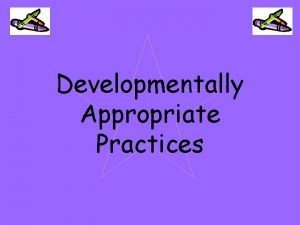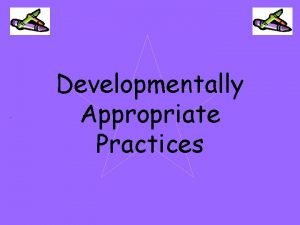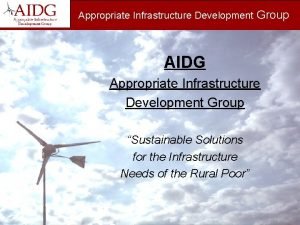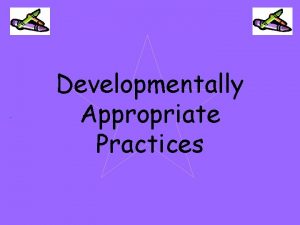Designing Nationally Appropriate Mitigation Actions An Approach Initiating























- Slides: 23

Designing Nationally Appropriate Mitigation Actions: An Approach Initiating the Discussion on Determining National Appropriateness of Mitigation Actions 15 November 2012 TERI, New Delhi Supported by

Outline of the presentation § § § § Overview of the project Need of the criteria? How to develop criteria? What should such criteria consist of? How to apply the criteria The criteria A tentative illustration Points for discussion

Overview of the project (NAMA) § Work Package 1: Developing the criteria to assess ‘appropriateness’ of actions in given ‘national’ circumstances. – Task 1. 1: Conceptualizing the Criteria – Task 1. 2: Vetting the Criteria in Different Country Contexts § Work Package 2: Identify NAMAs in selected countries – Task 2. 1: Identification of Potential Mitigation Actions – Task 2. 2: Assessing Appropriateness of Potential Mitigation Actions § Work Package 3: Assess and enhance the preparedness of regulatory, policy and institutional arrangements in selected countries – Task 3. 1: Assessing Country Preparedness – Task 3. 2: Examining International Architecture – Task 3. 3: Enhancing Preparedness

Need of the criteria § Environmental problems are complex: high level of uncertainty; political in nature (Bardwell, 1991) – Same extends to climate change problem, especially mitigation – Selection of appropriate mitigation options is further complex (Ramanathan, 1998) § Different ways of constructing the problem and different paths to solving it (Bardwell, 1991) – Availability of different mitigation options/choices. But, what is the best ? And the most appropriate ? § Resolving the climate change problem entails more than a technical solution; Requires a combination of social, economic, political, and institutional buy in(Solomon & Hughey, 2007) – In the context of mitigation choices, how do we make it more inclusive & participatory ?

Need of the criteria § Mitigation actions can range from purely technological to purely behavioural or as combinations § Policies, measures and instruments (read: NAMAs) are tools to trigger the implementation of mitigation actions § Instrument that works well in one country may not work well in another country with different social norms and institutions (IPCC, 2007) – Policy-makers need to evaluate instruments before they make choice – Role of other stakeholders & holistic perspective important given the nature of the problem § There are gaps in evaluation of climate policy instruments to select the most appropriate instruments (SYKE, 2007)

How to develop the criteria? § What does a NAMA entail ? § NAMA = Nationally Appropriate + Mitigation action Mitigation Actions NAMAs Nationally Appropriate A ‘good’ NAMA proposal is developed from within the country in a participatory process to gain /organise local commitments -(Höne & Jung, 2010) Key Questions : § What is National Appropriateness? § How to define/assess NA in NAMAs? Who defines/ assesses NA ? § How to make the process of identification of NAMAs more participatory ?

Purpose should be to§ Identify constituent elements (environment, economic, technological, social. . more? ) defining national appropriateness § Provide a common tool that could be used by all countries (similarity in approach), applicable to multiple sectors (flexible) and is futuristic (ex ante evaluation) § Facilitate policy-makers in selecting the most ‘appropriate’ mitigation action from a broad spectrum of choices – Could be applied in making ex-ante choices of mitigation actions and in expost evaluation of the performance of mitigation actions – But, not an alternative to the normal policy process rather a tool to inform policy process § Enable prioritization of identified options or NAMAs ? Enable classification of NAMAs ?

Steps in our approach to study Decision Goals Mitigation option Selection of criteria § § Expert consultations/interviews Literature Review Determination of the weights § § zz Expert consultations/interviews Questionnaire survey we are here Formalizing the criteria Assessing the options § § Expert consultations/interviews Questionnaire survey Prioritized Actions NAMAs

We build on: § Literature Review § Stakeholder consultation and questionnaire survey § Analysis of NAMA proposals in pipeline § Impressions from discussions in workshops/conferences and submissions to UNFCCC

and we find that: § A multi-criteria approach in unavoidable – Captures complexity and multiplicity of perspectives, central to environmental decision making (Phekar & Ramachandran, 2003; Greening & Bernow , 2004; Solomon & Hughey, 2007; Wang et al, 2009) – Provides comprehensive, participatory and qualitative assessment (Browne & Ryan, 2010) § All criteria must be measurable – Combination of scales § Discursive application – From AHP to ANP: problem of rank reversal (Ji and Jiang 2003) – Incommensurability of values (Martinez-alier et al. 1998)

What should such criteria consist of? § Four principal criteria for evaluating environmental policy instruments (IPCC 2007): – Environmental effectiveness – the extent to which a policy meets intended environmental objective or realizes positive environmental outcomes. – Cost-effectiveness – the extent to which the policy can achieve its objectives at a minimum cost to society. – Distributional considerations – the incidence or distributional consequences of a policy, which includes dimensions such as fairness and equity, although there are others. – Institutional feasibility – the extent to which a policy instrument is likely to be viewed as legitimate, gain acceptance, adopted and implemented. But, not necessarily ‘appropriateness’… consultation, questionnaire survey, discourse analysis, review….

Results of questionnaire survey

Results of the Questionnaire Survey

The four criteria-clusters § Transformation of Economy – Primary or immediate impacts – Secondary, tertiary impacts [ripple effect] – No compromise with development and environmental well being § Distributive and structural impacts – No freezing of inequality – No high-emission lock-ins § Economic and institutional feasibility – Economic viability – Environmental safeguards § International climate policy context – Watchful of nature, type and conditions of support

Scoring and decision-making scheme Criteria Cluster X Primary impacts Ripple effect Aggregate Score Positive Scale. PP Scale. PR b (P, R) s. t. b >x is A Negative Scale. NP Scale. NR c (P, R) s. t. c < y is A x and y to be determined politically, would reflect national context Criteria Cluster Positive Score Transformation of economy Distributive and structural impact Economic and institutional feasibility International Climate policy context Deliberations Negative Score

How to apply the criteria § Iterative process – Eliminate or reduce negative impacts – Adequate financial, institutional, and technological scale § But there is no limit on number of iterations, therefore within a time-frame of 15 -20 years – C. Freeman and C. Perez: technolo-economic paradigm (19852004)

Unbundling criteria-clusters § Positive impacts Economic and Transformation of Distributive and International climate Institutional feasibility Economy structural impacts Policy Context Temporal Scale of Improved quality of life Sufficiency of existing Need for international impacts (access to clean energy regulations (e. g. finance and drinking water, environmental safety) mobility, shelter, food security, sanitation) Technological capability Social justice (caste, Meeting with the Availability of gender) stipulated regulations international finance Emission reduction Equality among states Reduced imports Type of international finance Increased private sector Employment Increased exports Need for international participation generation technology transfer Infrastructure Rural development Cost effectiveness MRViability of actions development Conservation of natural Environmental well Capacity of local resources being institutions (fossil fuels, water)

Unbundling criteria-clusters § Negative impacts Transformation of Economy High emission lock-in Duration of lockin Distributive and structural impacts Increased income inequality Employment loss over the project period Economic and Institutional feasibility Violation of constitutional provisions Need new institutions Worsened Social Justice Appropriateness of (Caste, Gender) new institutions Increased Rural-Urban Divide Increased imports Reduced exports Need for FDI International climate Policy Context Support in the form of export subsidy Conditional (other than MRV) support Need for training

Scoring: A demo § Positive impacts: Transformation of economy Sub-criteria Temporal impacts Scale Primary impacts (P) Ripple effect (R) of Less than 5 yrs (7), 5 - More than 15 yrs(7), 10 -15 10(5), 10 -15 (3), more (5), 5 -10 (3), less than 5 (1) than 15 (1) Technological capability From equipment (1), equipment+training (3) to complete technology transfer (5) Emission reduction Yes (2), No (1) Increased private Yes (2), No (1) sector participation Sub-criteria score Px. R >15 is appropriate >25 is must Px. R >=9 is appropriate 25 is must From domestic technology diffusion (1), transfer of existing technology (3) to transfer and development of new technology (5) Extremely high (7)-5 -3 - Px. R positive(1) > 5 is appropriate 14 is must Extremely high (7)-5 -3 - Px. R positive(1) > 5 is appropriate >10 is must Cluster aggregate = avg (sub-criteria score / max. Px. R)

Scoring example: The Solar Mission § Positive impacts: Transformation of economy Sub-criteria Temporal impacts Scale Primary impacts (P) of Less than 5 yrs (7) Technological capability Equipment training (3) Emission reduction Yes (2) Increased private Yes (2), sector participation Ripple effect (R) Sub-criteria score 10 -15 years (5) Px. R = 35 >15 is appropriate >25 is must + Transfer of existing Px. R = 9 technology (3) >=9 is appropriate 25 is must High (5): One needs to Px. R = 10 calculate emissions in the > 5 is appropriate supply chain 14 is must High (5) Px. R = 10 > 5 is appropriate >10 is must Cluster aggregate = avg (sub-criteria score / max. Px. R) =((35/49)+(9/25)+(10/14))/4 = 63% > 35% [benchmark]

Way forward: expectations from the Roundtable § views and inputs towards suitability of the overall approach § reflections on the adequacy of the range and type of criteria (including need of ‘veto criterion’), and measurement scales § direction towards aggregation of individual criterion scores into representative score of respective criteriacluster.

DISCUSSIONS

Lit review: How does FCCC define NA? § Art 3. 2 : ‘specific needs and special circumstances of developing country Parties. . . ’ § Art 3. 4 : ‘. . . Policies and measures. . . should be appropriate for the specific conditions of each Party and should be integrated with national development programmes, taking into account that economic development. . . ’ § Art 4. 1 : ‘All Parties, taking into account their. . . specific national and regional development priorities, objectives and circumstances’ § Art 4. 1 (f) : ‘employ appropriate methods. . . formulated and determined nationally’
 Speed stacks spreads nationally in 1998.
Speed stacks spreads nationally in 1998. Initiating process group
Initiating process group Bcf model conflict resolution
Bcf model conflict resolution Attending responding personalizing initiating
Attending responding personalizing initiating Problem has been detected
Problem has been detected Initiating and planning systems development projects
Initiating and planning systems development projects Initiating and planning systems development projects
Initiating and planning systems development projects A problem has been detected and windows 7
A problem has been detected and windows 7 Requirement validation in software engineering
Requirement validation in software engineering Leadership challenges for the youth of today nstp
Leadership challenges for the youth of today nstp Chapter 13 initiating the sale
Chapter 13 initiating the sale Knapp stages
Knapp stages Appropriate
Appropriate Selection of an appropriate project report
Selection of an appropriate project report Mitigation tactics
Mitigation tactics Ransomware mitigation strategies
Ransomware mitigation strategies Credit union enterprise risk management
Credit union enterprise risk management The word mitigation has come to mean to
The word mitigation has come to mean to Vm sprawl definition
Vm sprawl definition Malloc vulnerability
Malloc vulnerability Mitigation
Mitigation Blossomfield tennis club
Blossomfield tennis club Water mitigation beaumont
Water mitigation beaumont Buffer overflow mitigation
Buffer overflow mitigation





